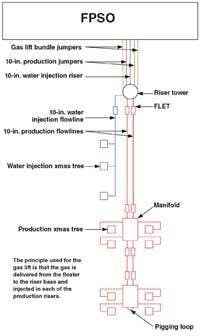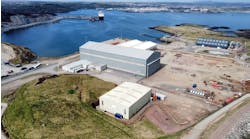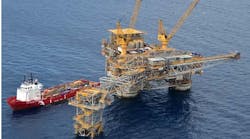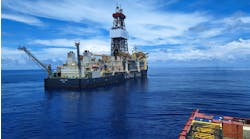Electrical submersible pump provides low-cost, high-efficiency pumping solution
null
Olivier Saincry, W. L. Hudson, M. D’Arcangues - Doris Engineering
An innovative design has been developed that provides artificial lift to the well stream by incorporating a cost-effective downhole submersible pump into a riser tower.
Doris Engineering’s concept provides an alternative to the gas lifted riser, which has found an application on deepwater developments and can be applied in cases where gas lift alone does not provide sufficient energy to boost the production.
Deepwater challenges
Deep and ultra deepwater production presents challenges to developing viable solutions such as:
- Difficult access for installation and maintenance
- Larger flow rate due to commingled flow of several wells in one riser
- Increased internal pressure
- Increased external hydrostatic pressure
- Low external sea water temperature.
As water depth increases, the required head to overcome the hydrostatic pressure from the liquid column in the vertical risers also increases. An effective flow enhancement solution is therefore vital for the field economy of subsea developments in deep/ultra deepwater.
For a deepwater field, the contribution of hydrostatic pressure losses due to fluid weight is much higher than friction losses, even at high flow rates.
This is even more the case when the water cut starts to be of importance because the multiphase fluid becomes heavier with less gas, and liquid density increases with the presence of water.
Production can be enhanced at the riser base by using two different principles: adding mechanical energy; lightening the fluid in the riser.
Solution concepts
The industry’s conventional solution is to use riser base gas lift to lighten the fluid. However, this may be faced with several technical and operational challenges when the water depth increases (such as more apparent slugging, limited capacity, and high erosion velocities).
Other means of enhancing the well stream therefore need to be investigated, such as the use of subsea separation with water removal to lighten the fluid and reduce riser base pressure.
Another approach is to add mechanical energy to the well stream to compensate for the increasing riser base pressure such as using multiphase pumps, or gas/liquid separation and single-phase boosting pumps. Both of these methods can be used in combination with the boosting riser tower.
Gas lifting riser tower
For deepwater fields, the conventional architecture is to consider a riser base gas lift. This approach is valid for any type of risers: riser towers, steel catenary risers, flexible risers, single hybrid risers, and equivalent.
The principle used for the gas lift is that the gas is delivered from the floater to the riser base and injected in each of the production risers. Injected gas will reduce the average density of the fluid in the riser and thus reduce the static pressure drop in the riser.
The subsea part of the field is organized around production loops, which all go back through the riser to the FPSO. Typically, the loops have two four-branch manifolds with a cluster of wells.
Associated to each production loop, a single water injection flowline with wells tied back to it, is usually installed.
Regarding the riser tower itself, it is equipped with two production risers for the loop; one water injection riser for the single injection flowline; and two gas lift risers to bring the gas down to the riser base.
Boosting riser tower
One way of adding mechanical power to the well stream would be to install a multiphase pumping station. The multiphase pumping station is normally installed as close as possible to the wellhead cluster to take advantage of the lower gas volume fraction. This location for the pumping station is also driven by the restrictions of access around the FPSO and risks of dropped objects.
An alternative to the installation of a pumping module, with its umbilicals and spools, is to use a boosting riser tower (BRT) that takes advantage of the proximity of the surface production vessel and minimizes the electrical energy loss.
The field configuration is similar to the gas lift architecture, however, there is no requirement for gas compression and gas lift risers since the pumps are within the riser tower.
The system does not change the composition of the effluent in the riser, and in operation it essentially reduces the pump suction pressure that is seen as the back pressure for the well. The pump discharge pressure is only marginally increased due to friction in the riser.
Although the use of a boosting element inside the riser tower is part of the initial development scheme of the field, the installation of the boosting element can be delayed until the increase of the water cut prevents significant natural flow production.
Several benefits of the BRT over a multiphase pumping station or gas lift system have been identified, in addition to being used for applications with subsea separation, where single-phase pumps can be used instead of multiphase pumps. So the riser tower can then be applied in any of the deep and ultra deepwater field developments.
BRT design
The BRT is based on the same principle as the bundle hybrid riser system, with the addition of boosting elements and associated risers as used for the Girassol field development, where the riser tower is equipped with:
- two production risers used for pigging and normal production, when boosting is not required
- two pumping production risers equipped with the electrical submersible pump (ESP) and tubing assembly used for boosting the well stream
- one water injection riser
- a number of service lines, as required for the field development.
Boosting element
The boosting element inside the riser tower is a conventional downhole pump. The company selected an ESP for this design, but a hydraulic submerged pump would also be applicable. However, the design of the BRT is not dependent on the type of ESP to be integrated. It is therefore more convenient for operators to select their usual pump manufacturer.
The ESP is positioned inside the riser of the riser tower using a tubing-like assembly system, with a hanger arrangement at the top. The assembly joints may be connected to one another using Merlin-type connectors that can be made-up or taken apart many times using a simple hydraulic tool.
BRT bottom assembly
The riser tower bottom assembly is similar to the existing riser tower. Each of the production risers are linked to the flowline end termination via a flowline spool. The connection between the production riser and the pumping riser is achieved through a ring main at the bottom of the tower. All risers are equipped with ROV-operated ball valves so that any of the risers can be isolated from the well stream.
BRT top assembly
The top of the riser tower is equipped with a buoyancy tank where the flexible jumpers are connected. In order to access the top of the pump in a production riser the U shape spool needs to be removed, but the flexible jumpers remain connected. The top of the pumping production riser is designed to support a hanger on which the ESP and the tubing assembly are suspended. The hanger is equipped with a penetration for the electrical cable going to the ESP.
Intervention casing installation
A surface vessel using an intervention casing (IC) can replace the ESP inside the BRT. This operation is very similar to the intervention that would take place for the retrieval of an ESP inside a well.
The operation has been planned to be done with a supply/light intervention vessel. At a depth of 50 m, divers can be used to work on the top of the buoyancy tank. Although not a requirement, an ROV can be used to observe the system during intervention and assist or replace the divers for the tasks that have to be done.
The IC is used to provide a link between the riser top assembly on the buoyancy tank and the surface. It is supported on the surface by the overboarding platform and is connected using a Graylock system onto the riser top assembly.
To connect the IC, the U shape spool on top of the production riser is removed by divers or ROV. The operator lowers the crane hook into the water, passing through the IC and connected to the ESP hanger. The IC can then be connected to the riser top assembly using the Graylock connector.
Once the IC is in place, the ESP can be recovered in a manner similar to a well intervention where the ESP hanger is retrieved to the surface using the crane. Each 24-m tubing joint can be disconnected, lifted off the overboard platform, and then stored in the pipe rack at which time the ESP is recovered with the intervention riser.
From a cost point of view, a subsea multiphase pump is five to ten times more expensive than an ESP. Taking into consideration the additional pumping risers, it is clear that the BRT will provide a cost effective solution for flow enhancement in deepwater and ultra deepwater when gas lift alone is not sufficient.





